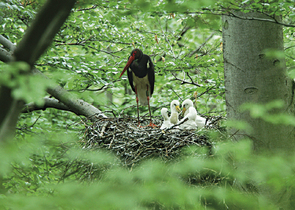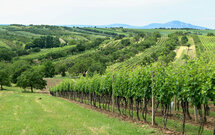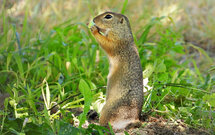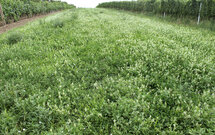The Journal is published by the Nature Conservation Agency of the Czech Republic in cooperation with the Cave Administration of the Czech Republic, the Krkonoše Mts. National Park Administration, the Bohemian Forest Mts. National Park Administration, the Podyjí National Park Administration and the The Bohemian Switzerland National Park Administration. It has been published since 1946.
cs / en
Nature Conservation 4/2009 — 31. 8. 2009 — Research, Surveys and Data Management — Print article in pdf
Do Our Black Storks Nest in Our Country? Black Stork Monitoring in the Czech Republic: the Most Rece
Sledování čápů černých v ČR – nejnovější poznatky

In the Czech Republic, 2,084 Black Storks (Ciconia nigra) were banded with colour rings in 1994–2008. Some hundreds of recoveries and findings have been obtained, particularly from migration, far less from the breeding season. 28 birds with rings were found on their nests, other six adults were observed in suitable habitats during the breeding season.
The average distance from place of birth to residence sites is 104 km (n=32). One third (34 %) of birds nested within 30 km from their places of birth, more than half of them, namely 56 %, settled within 60 km, while sharply three quarters of the birds studied dispersed for nesting within 120 km. The map No. 2 shows sites where storks were ringed and where they nested as well as the direction of their dispersal from places of birth. It is clear that birds move in all directions, with any relation hardly to be found. From five birds which have settled at the longest distance from their places of birth, four moved to west and one to south. Therefore, the effect of sex in Back Storks on the distance of settling from the place of birth is debated. Six males nested maximally some dozens of kilometres from their places of birth, while on the contrary the only female breed at a distance of 245 km. It would suggest, that similarly to some other raptors and also to the White Stork (Ciconia ciconia), Black Stork males display stronger relations to their places of birth and settle more closely to them. The average age in a nesting individual was calculated at 4.8 years at the first reporting of the breeding bird. Some storks nested repeatedly, in up to seven consequent years. When including all such nestings, the average age is, of course, higher, reaching 5.6 years. The youngest bird bred exceptionally as two-year-old, while the oldest was 12 years old. Three and six-year old Black Storks were the most common as breeders (Fig. 4).
Název připojené galerie
Quisque egestas velit non nulla fermentum, aliquet pharetra nunc malesuada. Nullam molestie vel diam non tincidunt. Sed pulvinar lacinia nunc et consectetur. Duis varius leo ac ex scelerisque, ullamcorper eleifend massa consectetur. Nullam in metus ac arcu pellentesque venenatis ac id lorem. Nulla nec ipsum sed enim sodales blandit a sit amet ex.




